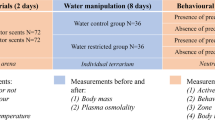Summary
Decreasing levels of simulated solar radiation have the following effects in the diurnal basking lizard Lacerta vivipara: (i) increase in time spent basking with a consequent decrease in time available for foraging (ii) decrease in speed of movement whilst foraging (iii) decrease in total foraging distance, and hence contact with potential prey (iv) decrease in searching efficiency in an experimental arena. Complete absence of simulated solar radiation accentuates these effects, and reduces the proportion of faster-moving prey in the diet. Time taken to swallow prey (handling time) increases exponentially with decreasing body temperature. It is concluded from these results that maintaining relatively high activity temperatures (30–36°C) is adaptive for the species because the loss of potential foraging time caused by lengthy periods of basking is offset by the following advantages: increased contact with and capture of prey, increased efficiency of prey handling, and availability of a wider range of prey types.
Similar content being viewed by others
References
Avery RA (1962) Notes on the ecology of Lacerta vivipara. Br J Herpetol 3:36–38
Avery RA (1966) Food and feeding habits of the Common lizard in the West of England. J Zool 149:115–121
Avery RA (1971) Estimates of food consumption by the lizard Lacerta vivipara Jacquin. J Anim Ecol 40:351–365
Avery RA (1976) Thermoregulation, metabolism and social behaviour in Lacertidae. In: Bellairs Ad'A, Cox CB (eds) Morphology and biology of reptiles, Linnean Society of London Symposium Series nu 3. Academic Press, London New York, pp 245–259
Avery RA (1982) Feeding ecology of the nocturnal gecko Hemidactylus brookii in Ghana. Amphibia-Reptilia 1:269–276
Avery RA (1982) Field studies of body temperatures and thermoregulation. In: Gans C, Pough FH (eds) Biology of the Reptilia, vol 12, Physiology C. Academic Press, London New York San Francisco, pp 93–166
Avery RA, McArdle BH (1973) The morning emergence of the Common Lizard Lacerta vivipara Jacquin. Br J Herpetol 5:363–368
Bennett AF (1980) The thermal dependence of lizard behaviour. Anim Behav 28:752–762
Burrage BR (1973) Comparative ecology and behaviour of Chamaeleo pumilus pumilus (Gmelin) and C. namaquensis A. Smith (Sauria: Chamaeleontidae). Ann S Afr Mus 61:1–158
Dawson WR (1975) On the physiological significance of the preferred body temperatures of Reptiles. In: Gates DM, Schmerl RB (eds) Perspectives of biophysical ecology. Ecological studies, vol 12. Springer, Berlin Heidelberg New York, pp 443–473
Gillett SD, Gonta E (1978) Locusts as prey: factors affecting their vulnerability to predation. Anim Behav 26:282–289
Greenberg N (1976) Thermoregulatory aspects of behaviour in the blue spiny lizard Sceloporus cyanogenys. Behaviour 59:1–21
Greenwald OE (1974) Thermal dependence of striking and prey capture by gopher snakes. Copeia 141–148
Hardy DF (1962) Ecology and behavior of the six-lined racerunner, Cnemidophorus sexlineatus. Univ Kansas Sci Bull 43:3–73
Huey RB (1974) Behavioral thermoregulation in lizards: importance of associated costs. Science 184:1001–1003
Huey RE, Slatkin M (1976) Costs and benefits of lizard thermoregulation. Q Rev Biol 51:363–384
Huey RB, Stevenson RD (1979) Integrating thermal physiology and ecology of ectotherms: a discussion of approaches. Am Zool 19:357–366
Janetos AC, Cole BJ (1981) Imperfectly optimal animals. Behav Ecol Sociobiol 9:203–209
Patterson JW, Davies PMC (1978) Preferred body temperature: seasonal and sexual differences in the lizard Lacerta vivipara. J Therm Biol 3:39–41
Pearson OP, Bradford DF (1976) Thermoregulation of lizards and toads at high altitudes in Peru. Copeia 155–170
Putnam RW, Bennett AF (1982) Thermal dependence of isometric contractile properties of lizard muscle. J Comp Physiol 147B:11–20
Spellerberg IF (1976) Adaptations of Reptiles to cold. In: Bellairs Ad'A, Cox CB (eds) Morphology and biology of reptiles, Linnean Society of London Symposium Series no 3. Academic Press, London New York, pp 261–285
Sveegaard B, Hansen IL (1976) Temperature regulation in lizards (Lacerta vivipara, L. agilis and L. pityusensis). Norw J Zool 24:232
Author information
Authors and Affiliations
Rights and permissions
About this article
Cite this article
Avery, R.A., Bedford, J.D. & Newcombe, C.P. The role of thermoregulation in lizard biology: Predatory efficiency in a temperate diurnal basker. Behav Ecol Sociobiol 11, 261–267 (1982). https://doi.org/10.1007/BF00299303
Received:
Accepted:
Issue Date:
DOI: https://doi.org/10.1007/BF00299303




